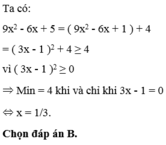

Hãy nhập câu hỏi của bạn vào đây, nếu là tài khoản VIP, bạn sẽ được ưu tiên trả lời.



a) \(ĐKXĐ:x\ne-3;x\ne2\)
b) \(P=\frac{\left(x+2\right)\left(x-2\right)}{\left(x+3\right)\left(x-2\right)}-\frac{5}{\left(x-2\right)\left(x+3\right)}-\frac{x+3}{\left(x-2\right)\left(x+3\right)}\)
\(P=\frac{x^2-4-5-x-3}{\left(x+3\right)\left(x-2\right)}\)
\(P=\frac{x^2-x-12}{\left(x+3\right)\left(x-2\right)}\)
\(P=\frac{\left(x+3\right)\left(x-4\right)}{\left(x+3\right)\left(x-2\right)}\)
vậy \(P=\frac{x-4}{x-2}\)
\(P=\frac{-3}{4}\) \(\Leftrightarrow\frac{x-4}{x-2}=\frac{-3}{4}\)
\(\Leftrightarrow4\left(x-4\right)=-3.\left(x-2\right)\)
\(\Leftrightarrow4x-16=-3x+6\)
\(\Leftrightarrow7x=22\)
\(\Leftrightarrow x=\frac{22}{7}\)
c) \(P\in Z\Leftrightarrow\frac{x-4}{x-2}\in Z\)
\(\frac{x-2-6}{x-2}=1-\frac{6}{x-2}\in Z\)
mà \(1\in Z\Rightarrow\left(x-2\right)\inƯ\left(6\right)\in\left(\pm1;\pm2;\pm3;\pm6\right)\)
mà theo ĐKXĐ: \(\Rightarrow\in\left(\pm1;-2;3;\pm6\right)\)
thay mấy cái kia vào rồi tìm \(x\)
d) \(x^2-9=0\Rightarrow x^2=9\Rightarrow x=\pm3\)
khi \(x=3\Rightarrow P=\frac{3-4}{3-2}=-1\)
khi \(x=-3\Rightarrow P=\frac{-3-4}{-3-2}=\frac{-7}{-5}=\frac{7}{5}\)

a) Để giá trị biểu thức 5 – 2x là số dương
<=> 5 – 2x > 0
<=> -2x > -5 ( Chuyển vế và đổi dấu hạng tử 5 )
\(\Leftrightarrow x< \frac{5}{2}\)( Chia cả 2 vế cho -2 < 0 ; BPT đổi chiều )
Vậy : \(x< \frac{5}{2}\)
b) Để giá trị của biểu thức x + 3 nhỏ hơn giá trị biểu thức 4x - 5 thì:
x + 3 < 4x – 5
<=< x – 4x < -3 – 5 ( chuyển vế và đổi dấu các hạng tử 4x và 3 )
<=> -3x < -8
\(\Leftrightarrow x>\frac{8}{3}\)( Chia cả hai vế cho -3 < 0, BPT đổi chiều).
Vậy : \(x>\frac{8}{3}\)
c) Để giá trị của biểu thức 2x +1 không nhỏ hơn giá trị của biểu thức x + 3 thì:
2x + 1 ≥ x + 3
<=> 2x – x ≥ 3 – 1 (chuyển vế và đổi dấu các hạng tử 1 và x).
<=> x ≥ 2.
Vậy x ≥ 2.
d) Để giá trị của biểu thức x2 + 1 không lớn hơn giá trị của biểu thức (x - 2)2 thì:
x2 + 1 ≤ (x – 2)2
<=> x2 + 1 ≤ x2 – 4x + 4
<=> x2 – x2 + 4x ≤ 4 – 1 ( chuyển vế và đổi dấu hạng tử 1; x2 và – 4x).
<=> 4x ≤ 3
\(\Leftrightarrow x\le\frac{3}{4}\)( Chia cả 2 vế cho 4 > 0 )
Vậy : \(x\le\frac{3}{4}\)

a) \(ĐKXĐ:x\ne\pm3;x\ne-6\)
Với \(x\ne\pm3;x\ne-6\), ta có:
\(P=\left(\dfrac{x}{x-3}-\dfrac{2}{x+3}+\dfrac{x^2}{9-x^2}\right):\dfrac{x+6}{3x+9}\\ =\left(\dfrac{x\left(x+3\right)}{\left(x-3\right)\left(x+3\right)}-\dfrac{2\left(x-3\right)}{\left(x+3\right)\left(x-3\right)}-\dfrac{x^2}{\left(x+3\right)\left(x-3\right)}\right)\cdot\dfrac{3\left(x+3\right)}{x+6}\\ =\dfrac{x^2+3x-2x+6-x^2}{\left(x+3\right)\left(x-3\right)}\cdot\dfrac{3\left(x+3\right)}{x+6}\\ =\dfrac{x+6}{\left(x+3\right)\left(x-3\right)}\cdot\dfrac{3\left(x+3\right)}{x+6}\\ =\dfrac{3}{x-3}\)
Vậy \(P=\dfrac{3}{x-3}\) với \(x\ne\pm3;x\ne-6\)
b) Ta có: \(2x-\left|4-x\right|=5\)
+) Nếu \(x\le4\Leftrightarrow2x-\left(4-x\right)=5\)
\(\Leftrightarrow2x-4+x=5\\ \Leftrightarrow3x=9\\ \Leftrightarrow x=3\left(Tm\right)\)
+) Nếu \(x>4\Leftrightarrow2x-\left(x-4\right)=5\)
\(\Leftrightarrow2x-x+4=5\\ \Leftrightarrow x=1\left(Ktm\right)\)
Với \(x\ne\pm3;x\ne-6\)
Khi \(x=3\left(Ktm\right)\rightarrow\text{loại}\)
Vậy khi \(2x-\left|4-x\right|=5\) không có giá trị.
c) Với \(x\ne\pm3;x\ne-6\)
Để P nhận giá trị nguyên
thì \(\Rightarrow\dfrac{3}{x-3}\in Z\)
\(\Rightarrow3⋮x-3\\ \Rightarrow x-3\inƯ_{\left(3\right)}\)
Mà \(Ư_{\left(3\right)}=\left\{\pm1;\pm3\right\}\)
Lập bảng giá trị:
| \(x-3\) | \(-3\) | \(-1\) | \(1\) | \(3\) |
| \(x\) | \(0\left(TM\right)\) | \(2\left(TM\right)\) | \(4\left(TM\right)\) | \(6\left(KTM\right)\) |
Vậy để P nhận giá trị nguyên
thì \(x\in\left\{0;2;4\right\}\)
d) Với \(x\ne\pm3;x\ne-6\)
Ta có : \(P^2-P+1=\dfrac{9}{\left(x-3\right)^2}-\dfrac{3}{x-3}+1\)
Đặt \(\dfrac{3}{x-3}=y\)
\(\Rightarrow P^2-P+1=y^2-y+1\\ =y^2-y+\dfrac{1}{4}+\dfrac{3}{4}\\ =\left(y^2-y+\dfrac{1}{4}\right)+\dfrac{3}{4}\\ =\left(y-\dfrac{1}{2}\right)^2+\dfrac{3}{4}\)
Do \(\left(y-\dfrac{1}{2}\right)^2\ge0\forall y\)
\(\Rightarrow P^2-P+1=\left(y-\dfrac{1}{2}\right)^2+\dfrac{3}{4}\ge\dfrac{3}{4}\forall y\)
Dấu "=" xảy ra khi:
\(\left(y-\dfrac{1}{2}\right)^2=0\\ \Leftrightarrow y-\dfrac{1}{2}=0\\ \Leftrightarrow y=\dfrac{1}{2}\\ \Leftrightarrow\dfrac{3}{x-3}=\dfrac{1}{2}\\ \Leftrightarrow x-3=6\\ \Leftrightarrow x=9\left(TM\right)\)
Vậy \(GTNN\) của biểu thức là \(\dfrac{3}{4}\) khi \(x=9\)

a, \(A=\left(\frac{3}{x^3+x}-\frac{4}{x^2+1}\right):\frac{1}{x}\)ĐKXĐ : \(x\ne0\)
\(=\left(\frac{3}{x\left(x^2+1\right)}-\frac{4x}{x\left(x^2+1\right)}\right)x=\frac{3-4x}{x\left(x^2+1\right)}.x\)
\(=\frac{3x-4x^2}{x\left(x^2+1\right)}=\frac{x\left(3-4x\right)}{x\left(x^2+1\right)}=\frac{3-4x}{x^2+1}\)
b, Theo bài ra ta có : \(\left|x-2\right|=2\)
\(\Leftrightarrow x-2=\pm2\Leftrightarrow x=4;0\)
Thay x = 0 vào phân thức trên : \(\frac{3-4.0}{0^2+1}=\frac{3}{1}=3\)( ktm vì ĐKXĐ : x khác 0 )
Thay x =4 vào phân thức trên : \(\frac{3-4.4}{4^2+1}=\frac{3-16}{16+1}=\frac{-13}{17}\)
Vậy \(A=-\frac{13}{17}\)
a) ĐKXĐ : x3 + x \(\ne0\)
=> x(x2 + 1) \(\ne0\)
=> \(\hept{\begin{cases}x\ne0\\x^2+1\ne0\end{cases}}\)
\(A=\left(\frac{3}{x^3+x}-\frac{4}{x^2+1}\right):\frac{1}{x}=\left(\frac{3}{x\left(x^2+1\right)}-\frac{4}{x^2+1}\right):\frac{1}{x}\)
\(=\left(\frac{3}{x\left(x^2+1\right)}-\frac{4x}{x\left(x^2+1\right)}\right).x=\frac{\left(3-4x\right).x}{x\left(x^2+1\right)}=\frac{3-4x}{x^2+1}\)
b) Khi |x - 2| = 2
=> \(\orbr{\begin{cases}x-2=2\\x-2=-2\end{cases}}\Rightarrow\orbr{\begin{cases}x=0\\x=4\end{cases}}\)
Khi x = 0 => A = \(\frac{3-4.0}{0^2+1}=\frac{-1}{1}=-1\)
Khi x = 4 => A = \(\frac{3-4.4}{4^2+1}=\frac{3-16}{16+1}=\frac{-13}{17}\)

Dài quá trôi hết đề khỏi màn hình: nhìn thấy câu nào giải cấu ấy
Bài 4:
\(A=\frac{\left(x-1\right)+\left(x+1\right)}{\left(x+1\right)\left(x-1\right)}-\frac{2}{\left(x+1\right)\left(x-1\right)}=\frac{2\left(x-1\right)}{\left(x-1\right)\left(x+1\right)}\)
a) DK x khác +-1
b) \(dk\left(a\right)\Rightarrow A=\frac{2}{\left(x+1\right)}\)
c) x+1 phải thuộc Ước của 2=> x=(-3,-2,0))
1. a) Biểu thức a có nghĩa \(\Leftrightarrow\hept{\begin{cases}x+2\ne0\\x^2-4\ne0\end{cases}}\)
\(\Leftrightarrow\hept{\begin{cases}x+2\ne0\\x-2\ne0\\x+2\ne0\end{cases}}\)
\(\Leftrightarrow\hept{\begin{cases}x\ne-2\\x\ne2\end{cases}}\)
Vậy vs \(x\ne2,x\ne-2\) thì bt a có nghĩa
b) \(A=\frac{x}{x+2}+\frac{4-2x}{\left(x-2\right)\left(x+2\right)}\)
\(=\frac{x\left(x-2\right)}{\left(x+2\right)\left(x-2\right)}+\frac{4-2x}{\left(x+2\right)\left(x-2\right)}\)
\(=\frac{x^2-2x+4-2x}{\left(x+2\right)\left(x-2\right)}\)
\(=\frac{x^2-4x+4}{\left(x+2\right)\left(x-2\right)}\)
\(=\frac{\left(x-2\right)^2}{\left(x+2\right)\left(x-2\right)}\)
\(=\frac{x-2}{x+2}\)
c) \(A=0\Leftrightarrow\frac{x-2}{x+2}=0\)
\(\Leftrightarrow x-2=\left(x+2\right).0\)
\(\Leftrightarrow x-2=0\)
\(\Leftrightarrow x=2\)(ko thỏa mãn điều kiện )
=> ko có gía trị nào của x để A=0